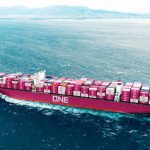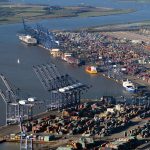HD Korea Shipbuilding & Offshore Engineering has unveiled a design model for a 15,000 TEU nuclear-powered container ship at the Houston Maritime Nuclear Summit held in Houston, USA, on Feb. 12 (local time). This innovative vessel, utilizing small modular reactor (SMR) technology, promises enhanced economic feasibility and safety, marking a significant step towards carbon neutrality in shipping.
The unveiling of this nuclear-powered container ship is the culmination of joint research efforts between HD Korea Shipbuilding & Offshore Engineering and TerraPower, a U.S. SMR specialist company founded by Bill Gates. This collaboration, which began in February last year, aims to revolutionize maritime propulsion by integrating advanced nuclear technology.
The ship’s design has received approval in principle (AIP) from the American Bureau of Shipping (ABS), a testament to its safety and feasibility. Patrick Ryan, chief technology officer of ABS, emphasized the potential impact of this innovation, stating, “Nuclear-powered vessels can be a game-changer in the current shipbuilding market where carbon neutrality is emerging.”
One of the key features of the nuclear-powered container ship is its supercritical carbon dioxide-based propulsion system, co-developed with Baker Hughes. This system improves thermal efficiency by 5% compared to existing technologies, offering a more sustainable and efficient power solution. The absence of an engine exhaust system or fuel tank allows for increased container loading capacity, further enhancing the ship’s economic viability.
Safety remains a paramount concern in the development of nuclear-powered vessels. To address this, HD Korea Shipbuilding & Offshore Engineering has implemented a marine radiation shielding system using a dual-tank method with stainless steel and light water. This design ensures robust protection against radiation, aligning with international safety standards.
The push towards nuclear-powered shipping is driven by the global imperative to reduce greenhouse gas emissions. The shipping industry, a significant contributor to global emissions, is under increasing pressure to adopt cleaner energy sources. Nuclear-powered ships, which do not emit carbon dioxide during operation, present a promising solution to this challenge.
HD Korea Shipbuilding & Offshore Engineering is committed to advancing this technology, with plans to complete the development of a maritime nuclear business model by 2030. Park Sang-min, head of the Green Energy Research Lab at the company, highlighted the importance of international collaboration in this endeavor. “We are strengthening cooperation with major classification societies and international regulatory bodies to establish international regulations necessary for the commercialization of nuclear-powered vessels,” he stated.
The historical context of nuclear-powered ships, primarily used in military applications, underscores the novelty of their application in commercial shipping. The integration of SMR technology in this sector represents a significant technological leap, with potential implications for global shipping practices.
Source: Business Korea






